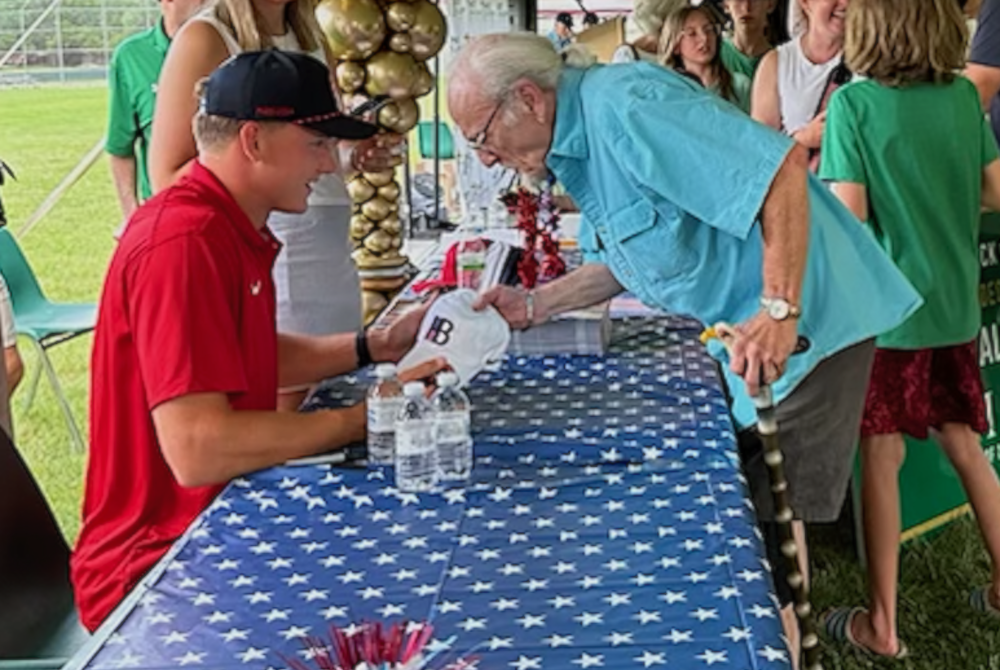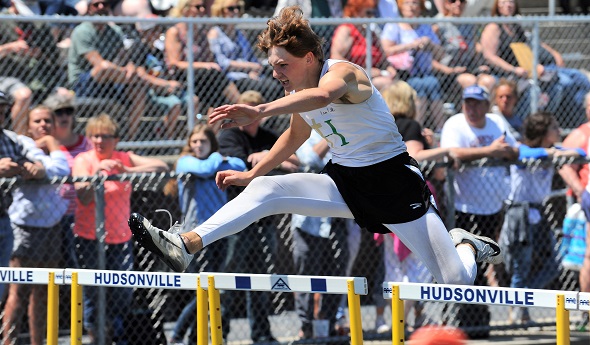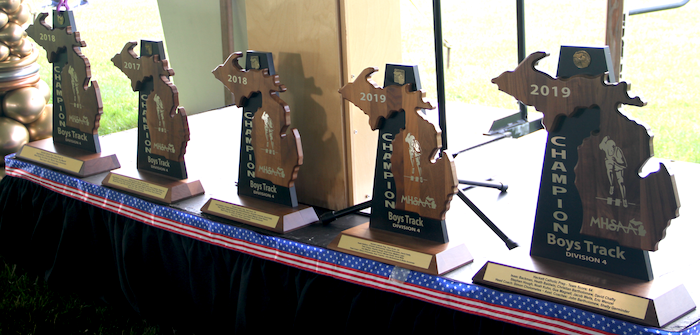
Track Gaining Speed Toward Future with Electronic Starting Devices
By
Steve Vedder
Special for MHSAA.com
May 23, 2023
Aubrey Greenfield thinks it might be the perfect time to reevaluate 130 years of tradition.
For a number of reasons, from technical to personal, the Oxford senior sprinter believes it makes sense for the crack of a starting pistol to be eliminated from high school track meets.
Because track meets would benefit in various ways from lowering costs to easier setup at meets to the human factor of competitors not having to flinch at the crack of a pistol shot, Greenfield believes the sport has a chance to embrace new technology – electronic starting devices (ESD).
In essence, an ESD replaces the starting pistol with a light flash, tone sound or both to begin a race.
"High school sports should put the athlete first," Greenfield said. "We should promote sports, and eliminating starting pistols promotes health in terms of PTSD or trauma for athletes and spectators and that would be good. I would like to think people would say that's a good idea."
In fact, Greenfield would go as far as to say if there was not an implementation of electronic starting devices, many of her teammates would have considered giving up the sport.
"If it's something that helps us compete safely, we're all for it," she said.
Greenfield's opinion apparently is spreading. Michigan High School Athletic Association senior assistant director Cody Inglis said the use of ESD makes it both affordable for meet starters and sensible for athletes and fans to rethink the use of starting pistols. While the MHSAA is not mandating electronic starting devices, it does promote the use of what Inglis calls "emerging technology." He notes that ESD are becoming the norm for organizations such as USA Track & Field, the NCAA and an increasing number of high schools.
 "I think we have to embrace new technology, and we think this will be something that takes hold," Inglis said.
"I think we have to embrace new technology, and we think this will be something that takes hold," Inglis said.
A key part of embracing ESD is the human element. The tragic Oxford High School shooting Nov. 30, 2021, that took the lives of four students while injuring seven others should not be relived even for a fleeting instance at a high school sporting event. Oxford athletic director Tony DeMare said the school began using ESD at every meet, including the MHSAA Lower Peninsula Division 1 Finals last June. He said that decision was embraced by virtually all schools Oxford encountered.
"We were very convinced that the alternative (of ESD) would promote a healthy attitude," DeMare said. "We were overwhelmed with the positive response. If a school was on the fence about it or might not be for it, I think we've started to see the tide turn in favor of people willing to listen and learn about electronic starting devices."
Inglis said the MHSAA is acutely aware of what the crack of a starting pistol can mean to athletes and fans.
"It's unimaginable what Oxford went through, and this is a small way we can help," he said. "We look at a (starting pistol) and think, ‘Could we do something else?’ It's a way of helping to solve a problem."
Over the last several years, the MHSAA has embraced finding an alternative to starting pistols. Inglis noted the discussion started with the cost and diminishing availability of 32-caliber ammunition that meet starters use. A box of ammunition, if it can be found, is around $75 a box.
In addition to cost, there is potential damage from excessive exposure to 150-plus decibels of sound generated by the traditional 32-caliber blanks. Medical studies show damage to ears caused by decibel levels above 120 dB.
The tragedy at Oxford accelerated the conversation.
Inglis said the cost of ESD can be likened to a school sinking money into artificial surfaces at football fields. Yes, there is a great cost at first, but over time money is ultimately saved. An ESD system itself ranges between $200 and $500. Speakers also may need to be purchased, but with ESD starting events like the 800 and 1,600-meter relays positioned near the outside lanes 8, 7, 6 and 5 would result in improved hearing by athletes at the start of a race.
There is one challenge with ESD that track administrators are working to overcome – lighting conditions that lessen the ability to see the ESD’s LED light or strobe when the button is pressed by a starter to begin a race. But that vision difficulty resulting from clear blue skies and backgrounds of setting suns can be substantially improved by incorporating a black background with an ESD – something as simple as a starter holding up black cardboard behind the lighting mechanism at the start of an event.
Inglis said when all factors are considered, the use of ESD makes sense.
 "With the climate we live in nowadays, no lookalike guns is good," he said. "We're not mandating this. But people are saying this is affordable."
"With the climate we live in nowadays, no lookalike guns is good," he said. "We're not mandating this. But people are saying this is affordable."
While switching to ESD would break 130 years of tradition, the timing could be a step forward, said Jeff Hollobaugh, co-author of the book "The Fleet Feet of Spring: Michigan's High School State Championships in Track & Field." He said while no definitive answer is possible, it's likely starting pistols were used at the inaugural state meet at the Jackson Fairgounds in 1895. The meet, which included events like tossing a 16-pound shot put, bike races and a 100-meter sprint, was sponsored by the Michigan Interscholastic Athletic Association (a predecessor to the MHSAA) and comprised mostly of the state's larger schools.
Hollobaugh's sentiments echo what many involved in today's high school track & field believe in terms of making a transition from starting pistols to electronic starting devices.
"It's a change, not necessarily good or bad, just different," he said. "It's not a drastic change, but it will take some getting used to. But it is the future. In the end, we'll all be fine."
DeMare believes the future of high school track will definitely include ESD.
"Our desire is that the practicality and sensibility of this will overcome the alternative," he said. "I think we'll see the automation and electronics taking hold of certain elements in track, and people will embrace it."
PHOTOS (Top) Runners watch official Bertha Smiley as they prepare to begin a race during last season's Lower Peninsula Division 1 Finals at Rockford. (Middle) An electronic starting device provided by VS Athletics was used to start those races. (Below) Smiley sets to begin an event. (Photos provided by David Kuderka/VS Athletics.)

Hackett Catholic Prep's Baldwin Carrying Hopes from Home to Paris
By
Pam Shebest
Special for MHSAA.com
July 12, 2024
KALAMAZOO — Heath Baldwin studied Spanish at Hackett Catholic Prep, but he will need to brush up on some French as he heads to Paris to compete in the 2024 Summer Olympics.
The recent Michigan State University grad, who earned a master’s degree in marketing and research analytics, will compete in the decathlon, a two-day event Aug. 2-3 at the Stade de France.
While the Olympics will be televised in the United States, because of the time difference, Baldwin’s events will take place locally during the early morning hours.
Wishing him a Bon Voyage, more than 200 former classmates, friends, family and well-wishers plus six television crews congregated Thursday for an impressive sendoff, starting with the Hackett “Summer Ensemble” playing the school fight song.
A 2019 Hackett grad, Baldwin led the track & field team to three Regional championships, two MHSAA Lower Peninsula Division 4 titles, was an individual five-time Finals champion, holds four school records and was named track & field Athlete of the Year for all divisions his senior season by the Michigan Interscholastic Track Coaches Association.
“I went through a lot at Hackett, obviously, with my dad (Roger) passing away (in 2016) and I always had a great support system of people who took care of my family and made sure we were doing good,” Baldwin said. “They’ve stuck with me through college, too, following me in all my events and to this point, so it’s cool that I’m doing well now and they’re along for the ride.”
 The ride will begin Tuesday when Baldwin travels to Germany to train before heading to Paris.
The ride will begin Tuesday when Baldwin travels to Germany to train before heading to Paris.
“Everything’s starting to feel more real,” he said. “I think once I get to Germany and start to train with other people, we’ll be able to get a little competitive. I think it will be fun training in Paris.”
Facing a huge crowd in Paris should not be a problem, he said.
“The more people will only help me. I’m a big adrenalin guy. I feel like I get more nervous talking at an event like this than I do for the Olympic Games.
“Once I get out on the track, everything just feels natural to me.”
Naturally a no-brainer
Baldwin’s Finals championships for Hackett had come in high jump, long jump and both hurdles races. Tackling the grueling decathlon was a no-brainer.
“I was good at the hurdles, high jump, long jump, which are three very technical events in the decathlon, so if you’re good at those three, you usually can pick up the other ones pretty easily is what they say,” he said.
“Also, I played baseball as a pitcher, so that correlated with the javelin. A lot of college coaches recruited me off that, I think.”
Baldwin said knew 2024 was an Olympic year, “so I thought it was something I maybe could do. After last year, when I scored above 8,000 points (in the decathlon) for the first time and came in sixth at the USAs, it became a little more realistic for me.”
The personable athlete not only qualified for the Olympics at this year’s U.S. Track & Field Trials in Eugene, Ore., but won the decathlon with a personal best 8,625 points.
He finished first in the shot put (54 feet, 2½ inches), high jump (6-11¾), 110 hurdles (13.77 seconds) and javelin throw (218-9).
 Other decathlon events are the 100 dash, long jump, 400 run, discus, pole vault and 1,500 run.
Other decathlon events are the 100 dash, long jump, 400 run, discus, pole vault and 1,500 run.
Baldwin earned Great Lakes Region Indoor and Outdoor Field Athlete of the Year honors and was named first team Academic All-American with a 3.8 GPA.
"We were awestruck at his athletic achievements (at Hackett),” said Judge Paul Bridenstine, the “Voice of the Irish.”
“While he continued to play football, basketball, baseball exceptionally at Hackett, his athletic life was transformed when he was introduced to (former HCP track & field coach Simon Cholometes).”
Cholometes said Baldwin’s success is something that didn’t come out of nowhere.
“Heath put the wheels in motion a long time ago and worked harder than most people can even fathom,” he said. “I can remember 5:40 in the morning, Heath running sprints up that hill over there,” he said, pointing. “A foot of snow, running sprints up that tall hill.
“In college, he’s a Big 10 champ, three-time All-American, Great Lakes Region Indoor and Outdoor Field Athlete of the Year, MSU’s Athlete of the Year twice, holds five school records plus Big 10 records in heptathlon and decathlon.”
Family won't be far
Baldwin plans to be in Paris for the opening ceremonies and will be cheered on by his mom Suzann, sister Hope and brothers Aiden and Gowan.
The Olympian also will have a remembrance of his late father with him. He has a tattoo of his dad’s signature on the inside of his upper left arm.
 Losing his father “was a big part of my life and obviously changed my perspective in the way I train and the way I live in a way he’d be proud of,” Baldwin said.
Losing his father “was a big part of my life and obviously changed my perspective in the way I train and the way I live in a way he’d be proud of,” Baldwin said.
“We set some big goals going into this year and it’s been a dream. I love representing the Kalamazoo community and Michigan, Hackett and Michigan State.
“I like to remember everybody I compete for, and I think that gives you a bigger purpose when you go out there. That’s definitely something I’ll be doing at the Olympics in Paris. I’m excited to represent there and hopefully go for a medal.”
PHOTOS (Top) Health Baldwin, seated, signs a hat during his sendoff Thursday at Kalamazoo Hackett Catholic Prep. (2) Baldwin clears a hurdle during the 2019 MHSAA Finals. (3) A hurdle was gifted to Baldwin on Thursday. (4) MHSAA trophies Baldwin helped win decorated the stage for his sendoff. (Sendoff photo by Pam Shebest.)

